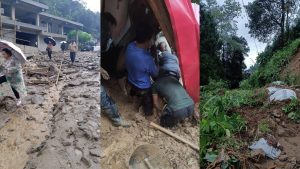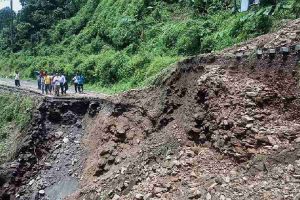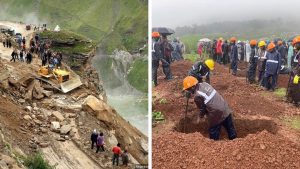Darjeeling – At least 23 people, including seven children, lost their lives after heavy rainfall triggered the devastating Darjeeling landslide across West Bengal’s hill district on Sunday. The catastrophic natural disaster flattened homes, damaged critical infrastructure, and isolated numerous remote areas, prompting large-scale rescue operations by national and state emergency response teams.
Extent of Darjeeling Landslide Casualties and Damage

The Darjeeling landslide fatalities were reported from multiple locations across the district, according to compiled reports from the National Disaster Response Force and district administration. Deaths occurred in Sarsaly, Jasbirgaon, Mirik Basti, Dhar Gaon (Mechi), Nagrakata, and the Mirik Lake area, indicating the widespread geographic impact of the disaster.
DG and IG of North Bengal Police, Rajesh Kumar Yadav, who personally examined affected sites, reported that the situation is gradually stabilizing despite the extensive damage. However, two people remain missing, and rescue operations continue in challenging terrain conditions that hamper equipment deployment and access to affected areas.
Extreme Rainfall Triggers Darjeeling Landslide


The Darjeeling landslide was triggered by extraordinary rainfall exceeding 300 millimeters within just 12 hours on Saturday night. This sudden deluge overwhelmed the region’s drainage capacity and destabilized hillsides already vulnerable due to geological factors. West Bengal Chief Minister Mamata Banerjee highlighted that simultaneous excessive water flow into the Sankosh River from Bhutan and Sikkim compounded the disaster’s severity.
The India Meteorological Department issued a red alert for sub-Himalayan West Bengal, including Darjeeling and Kalimpong districts, forecasting extremely heavy rainfall continuing until October 6. This weather warning prompted authorities to maintain heightened vigilance and prepare for potential additional Darjeeling landslide incidents or flooding.
Infrastructure Collapse Following Darjeeling Landslide
Critical infrastructure suffered catastrophic damage during the Darjeeling landslide disaster. Two major bridges collapsed, including the Balason Bridge in Kurseong and portions of the Dudhia Bridge in North Bengal, completely disrupting transportation networks. Roads remain blocked at multiple locations, rendering several interior villages completely inaccessible to relief efforts.
Also Read: SMS Hospital Fire Jaipur Tragedy: 8 Dead in Shocking ICU Blaze
Traffic on vital hill routes, particularly the Mirik-Sukhiapokhri road, has been severely affected due to mudslides and road collapses. The Siliguri mayor announced that the Public Works Department is constructing a temporary bridge to restore limited connectivity. A senior police officer described extremely difficult operating conditions, noting that terrain slipperiness and extensive house damage make assessment challenging while earthmovers struggle to function on unstable slopes.
Government Response to Darjeeling Landslide Crisis

Chief Minister Mamata Banerjee expressed deep concern over the Darjeeling landslide tragedy and flooding affecting both North and South Bengal. She conveyed condolences to bereaved families and promised immediate assistance to survivors. Banerjee, who monitored the situation from Nabanna, announced plans to visit the affected site on October 6 to personally assess damage and coordinate relief efforts.
Prime Minister Narendra Modi stated that authorities are closely monitoring developments in West Bengal following the Darjeeling landslide. Union Home Minister Amit Shah confirmed additional NDRF troops are on standby and spoke with the Darjeeling Member of Parliament regarding emergency response coordination. President Droupadi Murmu also expressed deep pain and regret over the loss of life in the disaster.
Bhutan Dam Overflow Compounds Crisis
Authorities in North Bengal issued major flood alerts after Bhutan’s Tala Hydropower Dam began overflowing due to technical failure. This overflow into the Sankosh River system threatens to exacerbate flooding already devastating areas affected by the Darjeeling landslide. The simultaneous occurrence of excessive rainfall and dam overflow creates compounded risks for downstream communities.
Bengal political parties urged the government to rush relief materials to affected areas as the dual crisis of the Darjeeling landslide and impending floods strains emergency response capabilities.
Regional Impact Across Eastern Himalayas
The Darjeeling landslide is part of broader severe weather conditions affecting the entire eastern Himalayan region. Nepal has reported more than 52 deaths from landslides and floods caused by heavy rainfall. Torrential downpours since Friday swelled rivers and inundated large areas across Nepal, with reports indicating almost 1,000 people trapped on the Tibetan side of Mount Everest.
In Bhutan, coordinated rescue operations by local authorities and the Indian Army ensured the safety of people affected by sudden flooding near the Amochu River. The regional nature of the disaster demonstrates how meteorological events transcend national boundaries in mountainous terrain.
Ongoing Rescue Operations


The NDRF deployed forces on war footing following bridge collapses and the Darjeeling landslide incidents. Rescue teams face extraordinary challenges accessing affected areas due to blocked roads, unstable slopes, and continuing rainfall. Emergency responders work to locate missing persons, evacuate vulnerable populations, and provide immediate assistance to survivors who lost homes and livelihoods.
Conclusion: Recovery Ahead
As the Darjeeling landslide situation gradually stabilizes, focus shifts to recovery, reconstruction, and implementing measures to prevent future disasters. The tragedy underscores vulnerabilities of Himalayan communities to extreme weather events and the critical importance of early warning systems, robust infrastructure, and coordinated emergency response mechanisms.

